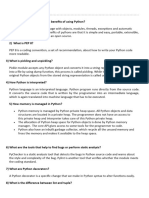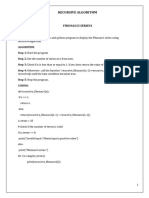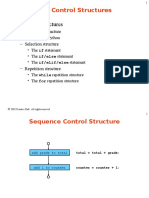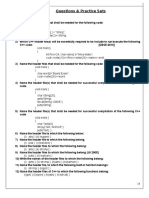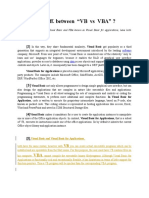0 ratings0% found this document useful (0 votes)
3K viewsModules and Packages in Python
Modules allow programmers to organize Python code logically and reuse code. A module is a Python file with a .py extension that contains function and variable definitions. Modules can be imported into other Python files and their functions can be accessed. Packages are groups of modules organized within a directory and can contain submodules in subdirectories. The import statement handles loading modules and packages in Python.
Uploaded by
Mishab ICopyright
© © All Rights Reserved
Available Formats
Download as PPT, PDF, TXT or read online on Scribd
0 ratings0% found this document useful (0 votes)
3K viewsModules and Packages in Python
Modules allow programmers to organize Python code logically and reuse code. A module is a Python file with a .py extension that contains function and variable definitions. Modules can be imported into other Python files and their functions can be accessed. Packages are groups of modules organized within a directory and can contain submodules in subdirectories. The import statement handles loading modules and packages in Python.
Uploaded by
Mishab ICopyright
© © All Rights Reserved
Available Formats
Download as PPT, PDF, TXT or read online on Scribd
You are on page 1/ 17
What are Modules?
Modules are files containing Python definitions and
statements (ex. name.py)
A module’s definitions can be imported into other
modules by using “import name”
The module’s name is available as a global variable
value
To access a module’s functions, type
“name.function()”
Modules…
A module allows you to logically organize your
Python code. Grouping related code into a module
makes the code easier to understand and use.
A module is a Python object with arbitrarily named
attributes that you can bind and reference.
Program using Module
The Python code for a module named
printfunction normally resides in a file
named printfunction.py.
Here's an example of a simple module,
printfunction.py
def print_func( param ):
print ("Hello : ", param)
return
More on Modules
Modules can contain executable statements along with
function definitions
Each module has its own private symbol table used as the
global symbol table by all functions in the module
Modules can import other modules
Each module is imported once per interpreter session
reload(name)
Can import names from a module into the importing
module’s symbol table
from mod import m1, m2 (or *)
m1()
From…import statement
Python's from statement lets you import specific attributes
from a module into the current namespace.
The from...import has the following syntax:
from modname import name1[,name2[,….nameN]]
For example, to import the function fibonacci from the
module fib, use the following statement
from fib import Fibonacci
This statement does not import the entire module fib into
the current namespace; it just introduces the item
fibonacci from the module fib into the global symbol table
of the importing module.
From …import * Statement
It is also possible to import all names from a module
into the current namespace by using the following
import statement
from modname import *
Executing Modules
python name.py <arguments>
Runs code as if it was imported
Setting _name_ == “_main_” the file can be used as a
script and an importable module
The Module Search Path
The interpreter searches for a file named name.py
Current directory given by variable sys.path
List of directories specified by PYTHONPATH
Default path (in UNIX - .:/usr/local/lib/python)
Script being run should not have the same name as a
standard module or an error will occur when the
module is imported
“Compiled” Python Files
If files mod.pyc and mod.py are in the same directory,
there is a byte-compiled version of the module mod
The modification time of the version of mod.py used
to create mod.pyc is stored in mod.pyc
Normally, the user does not need to do anything to
create the .pyc file
A compiled .py file is written to the .pyc
No error for failed attempt, .pyc is recognized as invalid
Contents of the .pyc can be shared by different
machines
Standard Modules
Python comes with a library of standard modules described in
the Python Library Reference
Some are built into interpreter
>>> import sys
>>> sys.s1
‘>>> ‘
>>> sys.s1 = ‘c> ‘
c> print ‘Hello’
Hello
c>
sys.path determines the interpreters’s search path for modules,
with the default path taken from PYTHONPATH
Can be modified with append() (ex. Sys.path.append(‘SOMEPATH’)
The dir() Function
Used to find the names a module defines and returns
a sorted list of strings
>>> import mod
>>> dir(mod)
[‘_name_’, ‘m1’, ‘m2’]
Without arguments, it lists the names currently
defined (variables, modules, functions, etc)
Does not list names of built-in functions and variables
Use _bulltin_to view all built-in functions and variables
Packages
“dotted module names” (ex. a.b)
Submodule b in package a
Saves authors of multi-module packages from worrying about
each other’s module names
Python searches through sys.path directories for the package
subdirectory
Users of the package can import individual modules from the
package
Ways to import submodules
import sound.effects.echo
from sound.effects import echo
Submodules must be referenced by full name
An ImportError exception is raised when the package cannot be
found
Importing * From a Package
* does not import all submodules from a package
Ensures that the package has been imported, only
importing the names of the submodules defined in
the package
import sound.effects.echo
import sound.effects.surround
from sound.effects import *
Intra-package References
Submodules can refer to each other
Surround might use echo module
import echo also loads surround module
import statement first looks in the containing package
before looking in the standard module search path
Absolute imports refer to submodules of sibling packages
sound.filters.vocoder uses echo module
from sound.effects import echo
Can write explicit relative imports
from . import echo
from .. import formats
from ..filters import equalizer
Packages in Multiple
Directories
_path_ is a list containing the name of the directory
holding the package’s _init_.py
Changing this variable can affect futute searches for
modules and subpackages in the package
Can be used to extend the set of modules in a
package
Not often needed
Sources
http://docs.python.org/tutorial/modules.html
You might also like
- Data Structures Using C, 2e Reema TharejaNo ratings yetData Structures Using C, 2e Reema Thareja30 pages
- CS3311-Data Structures Model Lab QP Print (Set-1)No ratings yetCS3311-Data Structures Model Lab QP Print (Set-1)2 pages
- UNIT - IV - Syllabus The Collections Framework (Java - Util)No ratings yetUNIT - IV - Syllabus The Collections Framework (Java - Util)24 pages
- Array Implementation of Stack, Queue and Circular Queue AdtsNo ratings yetArray Implementation of Stack, Queue and Circular Queue Adts12 pages
- Questions On Constructors and DestructorsNo ratings yetQuestions On Constructors and Destructors49 pages
- UNIT 2 - Python Programming - QUESTION BANK - 2023-24100% (1)UNIT 2 - Python Programming - QUESTION BANK - 2023-242 pages
- Design and Analysis of Algorithms Laboratory 10CSL47No ratings yetDesign and Analysis of Algorithms Laboratory 10CSL4728 pages
- Unit 1 Introduction of Machine Learning NotesNo ratings yetUnit 1 Introduction of Machine Learning Notes57 pages
- Write A Lex Program To Count No of Identifiers, Keywords, Digits100% (2)Write A Lex Program To Count No of Identifiers, Keywords, Digits13 pages
- Delhi University PHP Question Paper Solution0% (2)Delhi University PHP Question Paper Solution9 pages
- Python Question Bank (Descriptive) R19 PDFNo ratings yetPython Question Bank (Descriptive) R19 PDF5 pages
- LAB MANUAL Operating Systems Lab 3 - Process Creation: 1. Fork System CallNo ratings yetLAB MANUAL Operating Systems Lab 3 - Process Creation: 1. Fork System Call5 pages
- Unit-4: Transfer From Analysis To Design in The Characterization Stage: Interaction Diagrams100% (3)Unit-4: Transfer From Analysis To Design in The Characterization Stage: Interaction Diagrams40 pages
- Python Part IV: Modules & Packages Namespaces & Scopes ExceptionsNo ratings yetPython Part IV: Modules & Packages Namespaces & Scopes Exceptions18 pages
- Configurations (22%) :: Build and Deployment (8%)No ratings yetConfigurations (22%) :: Build and Deployment (8%)6 pages
- Opentext Whitepaper Opentext Process Suite Platform Architecture enNo ratings yetOpentext Whitepaper Opentext Process Suite Platform Architecture en48 pages
- Summer Internship Program (WEEK 4) : Presented By: Shreya GaurNo ratings yetSummer Internship Program (WEEK 4) : Presented By: Shreya Gaur20 pages
- Assignment 1 Front Sheet: Qualification BTEC Level 5 HND Diploma in Computing Unit Number and Title Submission DateNo ratings yetAssignment 1 Front Sheet: Qualification BTEC Level 5 HND Diploma in Computing Unit Number and Title Submission Date8 pages
- GUNT - Screen Mirroring - Connection, Mirroring, Data AcquisitionNo ratings yetGUNT - Screen Mirroring - Connection, Mirroring, Data Acquisition1 page
- Chapter 3 Software Frameworks For Real Lecture100% (1)Chapter 3 Software Frameworks For Real Lecture3 pages
- Object Oriented Analysis and Design: Anmol Bilal ShiekhNo ratings yetObject Oriented Analysis and Design: Anmol Bilal Shiekh22 pages
- UNIT - IV - Syllabus The Collections Framework (Java - Util)UNIT - IV - Syllabus The Collections Framework (Java - Util)
- Array Implementation of Stack, Queue and Circular Queue AdtsArray Implementation of Stack, Queue and Circular Queue Adts
- UNIT 2 - Python Programming - QUESTION BANK - 2023-24UNIT 2 - Python Programming - QUESTION BANK - 2023-24
- Design and Analysis of Algorithms Laboratory 10CSL47Design and Analysis of Algorithms Laboratory 10CSL47
- Write A Lex Program To Count No of Identifiers, Keywords, DigitsWrite A Lex Program To Count No of Identifiers, Keywords, Digits
- LAB MANUAL Operating Systems Lab 3 - Process Creation: 1. Fork System CallLAB MANUAL Operating Systems Lab 3 - Process Creation: 1. Fork System Call
- Unit-4: Transfer From Analysis To Design in The Characterization Stage: Interaction DiagramsUnit-4: Transfer From Analysis To Design in The Characterization Stage: Interaction Diagrams
- Python Part IV: Modules & Packages Namespaces & Scopes ExceptionsPython Part IV: Modules & Packages Namespaces & Scopes Exceptions
- Opentext Whitepaper Opentext Process Suite Platform Architecture enOpentext Whitepaper Opentext Process Suite Platform Architecture en
- Summer Internship Program (WEEK 4) : Presented By: Shreya GaurSummer Internship Program (WEEK 4) : Presented By: Shreya Gaur
- Assignment 1 Front Sheet: Qualification BTEC Level 5 HND Diploma in Computing Unit Number and Title Submission DateAssignment 1 Front Sheet: Qualification BTEC Level 5 HND Diploma in Computing Unit Number and Title Submission Date
- GUNT - Screen Mirroring - Connection, Mirroring, Data AcquisitionGUNT - Screen Mirroring - Connection, Mirroring, Data Acquisition
- Object Oriented Analysis and Design: Anmol Bilal ShiekhObject Oriented Analysis and Design: Anmol Bilal Shiekh





















